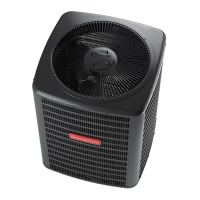What to do if Goodman Air Conditioner has too much air across indoor coil?
- JJordan LinSep 23, 2025
If there is too much air across the indoor coil of your Goodman Air Conditioner, reduce the blower speed.
What to do if Goodman Air Conditioner has too much air across indoor coil?
If there is too much air across the indoor coil of your Goodman Air Conditioner, reduce the blower speed.
What to do if Goodman GSC13048 has overcharge of refrigerant?
If you have an overcharge of refrigerant in your Goodman Air Conditioner, recover part of the charge.
How to fix loose connection in Goodman GSC13048?
If your Goodman Air Conditioner has a loose connection, inspect the connection and tighten it.
How to test shorted or broken wires in Goodman GSC13048?
If your Goodman Air Conditioner has shorted or broken wires, test the circuits with an ohmmeter.
What to do if Goodman Air Conditioner has noncondensibles?
If your Goodman Air Conditioner has noncondensibles, recover the charge, evacuate, and recharge.
What to do if Goodman Air Conditioner has not enough air across indoor coil?
If there is not enough air across the indoor coil of your Goodman Air Conditioner, increase the blower speed and check the duct static pressure.
What to do if Goodman GSC13048 has undersized liquid line?
If the liquid line is undersized in your Goodman Air Conditioner, replace the line.
What to do if Goodman Air Conditioner has undersized suction line?
If the suction line is undersized in your Goodman Air Conditioner, replace the line.
How to test faulty fan relay in Goodman GSC13048 Air Conditioner?
If your Goodman Air Conditioner has a faulty fan relay, test the continuity of the coil and contacts.
How to test shorted or grounded compressor in Goodman GSC13048 Air Conditioner?
If your Goodman Air Conditioner compressor is shorted or grounded, test the motor windings.
Information regarding nitrogen/helium holding charge, component replacement use, and pre-2010 system usage.
Essential safety information covering high voltage, refrigerant handling, and general precautions.
Requirements for technicians, owner warranty, shipping inspection, and codes.
Details minimum airflow clearances and considerations for unit placement and rooftop installations.
Covers insulation, burial, connections, and recommended tubing sizes for refrigerant lines.
Guidelines for wiring, high voltage safety, conductor use, and hard start kit requirements.
Procedure and table for measuring system superheat in fixed orifice systems.
Steps for pressure testing, evacuation, and adding refrigerant to the system.
Instructions for adjusting system charge and reference to superheat/pressure charts.
A comprehensive guide listing symptoms, possible causes, and test methods for diagnosing issues.
Information and links to company websites and a statement on product quality.
Information regarding nitrogen/helium holding charge, component replacement use, and pre-2010 system usage.
Essential safety information covering high voltage, refrigerant handling, and general precautions.
Requirements for technicians, owner warranty, shipping inspection, and codes.
Details minimum airflow clearances and considerations for unit placement and rooftop installations.
Covers insulation, burial, connections, and recommended tubing sizes for refrigerant lines.
Guidelines for wiring, high voltage safety, conductor use, and hard start kit requirements.
Procedure and table for measuring system superheat in fixed orifice systems.
Steps for pressure testing, evacuation, and adding refrigerant to the system.
Instructions for adjusting system charge and reference to superheat/pressure charts.
A comprehensive guide listing symptoms, possible causes, and test methods for diagnosing issues.
Information and links to company websites and a statement on product quality.
| SEER Rating | 13 |
|---|---|
| Compressor Type | Scroll |
| Refrigerant | R-410A |
| Operating Voltage | 208/230V |
| Phase | 1 |
| Sound Level | 76 dB |
| Cooling Capacity (BTU) | 48000 BTU |












